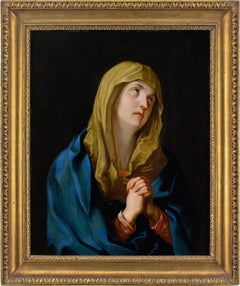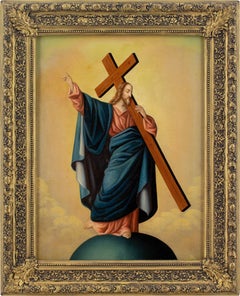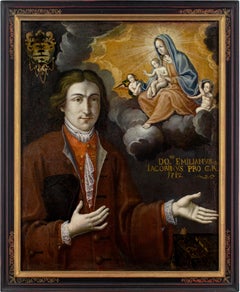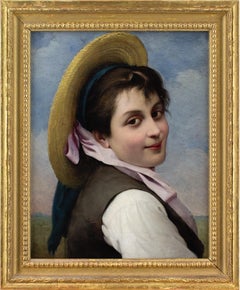Want more images or videos?
Request additional images or videos from the seller
1 of 13
UnknownEarly 17th-Century Bolognese School, Annunciation, The Reading Madonnac. 1600
c. 1600
$4,687.28List Price
About the Item
- Creation Year:c. 1600
- Dimensions:Height: 43 in (109.22 cm)Width: 35.5 in (90.17 cm)
- Medium:
- Movement & Style:
- Period:1600-1609
- Condition:Cleaned. Revarnished. Canvas relined. Faint stretcher marks. Later stretcher. Craquelure throughout. The paint layer is stable. Frame bowed due to its age and with various wear as you would expect.
- Gallery Location:Cheltenham, GB
- Reference Number:1stDibs: LU2328216351232
About the Seller
5.0
Platinum Seller
Premium sellers with a 4.7+ rating and 24-hour response times
Established in 2017
1stDibs seller since 2023
245 sales on 1stDibs
Authenticity Guarantee
In the unlikely event there’s an issue with an item’s authenticity, contact us within 1 year for a full refund. DetailsMoney-Back Guarantee
If your item is not as described, is damaged in transit, or does not arrive, contact us within 7 days for a full refund. Details24-Hour Cancellation
You have a 24-hour grace period in which to reconsider your purchase, with no questions asked.Vetted Professional Sellers
Our world-class sellers must adhere to strict standards for service and quality, maintaining the integrity of our listings.Price-Match Guarantee
If you find that a seller listed the same item for a lower price elsewhere, we’ll match it.Trusted Global Delivery
Our best-in-class carrier network provides specialized shipping options worldwide, including custom delivery.You May Also Like
A pleasant serenade Italian oil painting on canvas by Alessandro Sani 19Th c.
Located in Gavere, BE
A pleasant serenade Italian oil painting on canvas attributed to Alessandro Sani 19Th c.
Alessandro Sani (1856–1927) was an Italian painter, mainly of genre subjects.
He was born a...
Category
1890s Italian School Portrait Paintings
Materials
Gold Leaf
$4,250
H 24.02 in W 20.87 in D 2.76 in
LADY'S PORTRAIT - Venetian School - Oil on Canvas Italian Figurative Painting
By Giovanni Santaniello
Located in Napoli, IT
Lady's portrait - Giovanni Santaniello Italia 2002 - Oil on canvas cm. 100 x 80
The painting by Giovanni Santaniello depicts a portrait of a beautiful pensive woman in elegant clothe...
Category
Early 2000s Italian School Portrait Paintings
Materials
Canvas, Oil
$6,984
H 39.38 in W 31.5 in
LADY IN BLACK-In the Manner of G. Bodini Italy figurative oil on canvas painting
By Eugenio De Blasi
Located in Napoli, IT
LADY IN BLACK - Oil on canvas painting, Eugenio De Blasi, Italy, 2011
This is his reinterpretation of a greatest old master painting by Giovanni Boldini.
Gold leaf gilded and mohogan...
Category
Early 2000s Italian School Figurative Paintings
Materials
Canvas, Oil
$5,900
H 47.25 in W 23.63 in
SCENE WITH MINSTREL- Eugenio De Blasi - Italy -Oil on canvas painting
By Eugenio De Blasi
Located in Napoli, IT
Scene with Minstrel - Oil on canvas painting, Eugenio De Blasi, Italy, 2005
This is his reinterpretation of a greatest old master painting by Giovanni Boldini.
Category
Early 2000s Italian School Figurative Paintings
Materials
Canvas, Oil
$5,900
H 39.38 in W 31.5 in
PORTRAIT OF YOUNG WOMAN - Venetian School -Italian oil on canvas painting
By Eugenio De Blasi
Located in Napoli, IT
PORTRAIT OF YOUNG WOMAN - Oil on canvas painting cm.95x65, Eugenio De Blasi, Italy, 2008
The painting by Eugenio De Blasi is inspired by the work of the Venetian painter and portrai...
Category
Early 2000s Italian School Figurative Paintings
Materials
Canvas, Oil
$3,708
H 37.41 in W 25.6 in
Italian men portrait
By Giovanni Maria delle Piane dit Mulinaretto (Genoa 1670 - Monticelli d´Ongina 1745)
Located in BELEYMAS, FR
Giovanni Maria DELLE PIANE, known as IL MULINARETTO
(Genoa, 1660 – Monticelli d'Ongina, 1745)
Portrait of a man
Oil on oval canvas
H. 108 cm; L. 83 cm
Provenance: Nino Ferrari Colle...
Category
1740s Italian School Portrait Paintings
Materials
Canvas, Oil
Antique Italian Portrait of Old Fisherman with Pipe Characterful Chap
Located in Cirencester, Gloucestershire
Portrait of an Elderly Fisherman
Italian School, 19th century
oil on canvas, framed
Framed: 14 x 12 inches
Canvas: 10.5 x 9 inches
Provenance: private collection
Condition: several s...
Category
Late 19th Century Italian School Portrait Paintings
Materials
Oil
Mother and Daughter Italian School by Giuseppe Costa
Located in New York, NY
Giuseppe Costa (Italian, 1852-1912)
Untitled, c. late 19th-early 20th century
Oil on wood panel
12 x 7 in.
Framed: 16 1/2 x 11 2/3 x 1 in.
Signed lower right
Giuseppe Costa was an I...
Category
Late 19th Century Italian School Portrait Paintings
Materials
Oil, Wood Panel
$2,250
H 16.5 in W 11.33 in D 1 in
Portrait of a woman with a book
Located in BELEYMAS, FR
Italian school circa 1560, circle of Bernardino Campi
Portrait of a woman with a book
Oil on panel
H. 78 cm ; L. 57cm
Category
16th Century Italian School Portrait Paintings
Materials
Oil, Wood Panel
Portrait of Renaissance Lady Classical Medici Style Garden Italian Ornate Frame
Located in Cirencester, Gloucestershire
The Renaissance Lady
Roman School, circa 1890-1900 period
oil on board, framed in original Italian ornate frame
framed: 17.5 x 16.5 inches
board: 11 x...
Category
Early 20th Century Italian School Figurative Paintings
Materials
Oil
$6,065
H 17.5 in W 16.5 in
More From This Seller
View AllJoszef Schmidt, After Guido Reni Mater Dolorosa, Antique Oil Painting
Located in Cheltenham, GB
This early 19th-century oil painting by Hungarian artist Joszef Schmidt (1810-1875) depicts the Mater Dolorosa. It’s after a work by Italian artist, Guido Reni (1575-1642). Schmidt w...
Category
Early 19th Century Italian School Figurative Paintings
Materials
Panel, Oil
Early 19th-Century Central European School, Christ The Saviour
Located in Cheltenham, GB
This early 19th-century central European oil painting depicts Christ The Saviour standing atop an orb and carrying a cross over his left shoulder.
An unusual composition, Christ’s rather striking posture is perhaps more ‘Saturday Night Fever’ than it is sacramental. However, the iconography is archaic and derived ultimately from New Testament illustrations dating to the Middle Ages. Depictions of orbs are usually symbolic of the universe, while the cross alludes to redemption. Hence, it’s a visual representation of Christ as the Saviour of humanity.
Francisco de Zurbarán...
Category
1830s Portrait Paintings
Materials
Oil, Canvas
Early-18th Century French School, Ex-Voto Portrait With Emilian Jacobin
Located in Cheltenham, GB
This splendid early 18th-century French oil painting represents an ‘ex-voto’ with Emilian Jacobin and a depiction of the Virgin Mary with Christ and angels.
Ex votos are votive offe...
Category
1710s French School Portrait Paintings
Materials
Oil, Canvas
Giovanni Rota, Portrait Of A Girl In A Straw Hat
Located in Cheltenham, GB
This fine late 19th-century oil painting by Italian artist Giovanni Rota (1832-1900) depicts a cheerful young lady looking back over her shoulder with a straw hat and lilac ribbon.
...
Category
1880s Italian School Portrait Paintings
Materials
Oil, Canvas
18th-Century Venetian School, Mary Magdalene, Noli Me Tangere
Located in Cheltenham, GB
This late 18th-century Italian oil painting fragment depicts Mary Magdalene kneeling alongside an alabaster jar. Christ’s hand is partially visible above, along with his robes, which...
Category
18th Century Italian School Figurative Paintings
Materials
Oil, Canvas
John Verelst (Circle), Portrait Of A Young Lady With A Spaniel
By John Verelst
Located in Cheltenham, GB
This large early 18th-century full-length portrait depicts a seated young lady before a classical column and distant country house. It was formerly in the collection of Dalham Hall i...
Category
Early 18th Century Rococo Portrait Paintings
Materials
Canvas, Oil
Recently Viewed
View AllMore Ways To Browse
Annibale Carracci
Archangel Gabriel
Spanish Jewish
Terry Shelbourne
Tiziano Vecellio
16th Century Religious Painting
1860 Oil Painting Of Woman In Black Dress
Antique Oil Painting Skull
Antique Oil Portrait Child
Bernardino Campi
Consuelo Vanderbilt
David Alison
Dod Procter
Elizabethan Dress
Elizabethan Painting
Erik Olson
Francois De Troy
George Knapton



